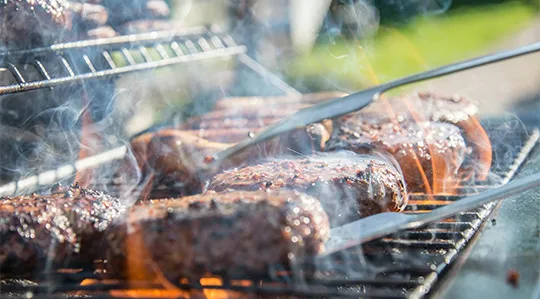Propane Cooking Appliances
Propane cooking appliances provide convenience, sharp design, and excellent performance in any kitchen — from starter homes to high-end custom projects. An attractive, stainless-steel gas range that combines a propane cooktop and oven is perfect for space-challenged homeowners, while propane also offers commercial-grade ranges, indoor grills and cooktops, in-wall double ovens, and other gas cooking applications in luxurious custom kitchens. In all cases, propane gives the homeowner ample cooking performance and precise temperature control in a wide variety of product designs.
Is It SAFE to Cook With Gas Stoves?
- There are competing studies about the adverse impact to indoor air quality that various types of stoves produce. Here are a few points to consider when answering questions about the matter:
- The Stanford study’s findings are based on an extremely small sample size and unrealistic cooking conditions and don’t provide a clear picture of NOx emissions and particulate matter generated from electric cooking.
- The Lancet Respiratory Medicine abstract states: “…we detected no evidence of an association between the use of gas as a cooking fuel and either asthma symptoms or asthma diagnosis.”
- Ultimately, further review is needed.
- The act of cooking itself reduces indoor air quality, regardless of the energy that powers the stove.
- Proper ventilation using a hood and even opening a window is the best solution to maintaining indoor air quality.
- Engaging a qualified technician to install and perform regular service of the stove is essential to ensuring safe operation of the appliance.
- Heating cooking oil at the appropriate temperature also aids in maintaining air quality.
- The safety of appliances is measured in ways other than their impact on indoor air quality. For instance, a 2020 study by the National Fire Protection Association (NFPA) found that electric ranges cause household fires at a rate 2.6 times greater than gas ranges; civilian injuries at a rate 4.8 times higher; and civilian deaths at a rate 3.4 times higher.
- There are inherent risks to operating any appliance in the home whether powered by electricity, natural gas, or propane. Following common sense safety measures will ensure their safe use for all.
Performance
High-performance gas ranges, cooktops, and ovens are preferred by a majority of professional chefs and designers, for their own use as well as for their clients. Why? Propane ranges, cooktops, and ovens allow for greater control of heat levels. Instant-on burners allow cooking to start right away. Propane burners are also instant-off. This capability provides a safety feature not found in electric cooktops, which can remain dangerously hot for a few minutes after they’ve been turned off. A propane burner’s instant-off feature also allows the food to start cooling immediately and prevents overcooking.
Beyond these core benefits of propane burners in ranges, cooktops, and even indoor grills, propane kitchen appliances also offer:
- Precise temperature control from searing to simmering.
- Smart controls for different cooking modes.
- Griddle and grill features on ranges and cooktops.
- Warming drawers.
- Ovens with convection and steam settings.
Energy Consumption & Costs
Propane ranges, ovens, and other cooking appliances will have wide variations in energy use and costs — depending primarily on frequency of use. Homeowners who use their range and/or oven daily will use more energy, while infrequent chefs will have low usage rates. A general annual estimate for propane use in the kitchen is 25 gallons per year.
Energy Efficiency
Cooking appliances are generally not a major energy end-use in the home, and residential cooking appliances are not labeled by the Energy Star program. In many parts of the country, however, the benefits of gas and propane cooking go to a much higher level. In regions like California, where peak demand period on the electric grid often occurs in the late afternoons of hot summer days, electric cooking is a major load. In fact, the energy factor of electric cooking — which compares its overall energy use to its energy use in peak demand times — makes it the second-most significant load in the home, behind air-conditioning. For this reason, switching to propane cooking can ease peak load issues with the electric grid and reduce electric bills in the process.
Environmental
Propane cooking results in lower CO2 emissions than electric cooking. This is true because a significant portion of electricity production comes from coal or oil-fired generation plants which release CO2 emissions as part of the generation process. Based on typical cooking usage levels and the emissions which electricity generation creates, propane cooking has roughly 30 percent fewer CO2 emissions.





